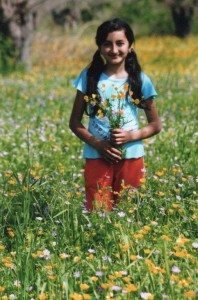SOS, NKR—Ever since the fifth century, when Mesrob Mashdots put his script to the Armenian alphabet and St. Gregory the Illuminator founded a church here one century earlier, Amaras Monastery has served as a mecca for tourists and locals alike.

The Church of St. Grigoris located inside this religious conclave serves as a burial ground for St. Gregory’s grandson, who died in 338. It is here that Mesrob Mashdots established the first-ever school that used his script.
The monastery was plundered in the 13th century by the Mongols, destroyed in a 1387 invasion, and demolished again in the 16th century. Its history is one of reincarnation, built and rebuilt as a vibrant stomping ground for daily transients.
Today, it is both a spiritual and horticultural delight for anyone who chooses to cross its path near the village of Sos in the Martuni county of the Nagorno Karabagh Republic (NKR).
Anything you need to know about this site can be told by its caretaker, Vaal Kalian, who greeted us at the entrance with a pleasing smile and a warm “Barev.” He walked with a limp.
The immediate presence of children and families stomping the grounds made a vast impression. I was quick to learn that the historical content competed very favorably with a recreational outlet that included rollicking fields of luscious flowers and a barbeque area.
Amaras was an oasis in the middle of a turbulent ocean, calm and collected—a place where folks could go to gather their thoughts and distance themselves from reality.
Vaal took us on a tour of the new chapel that houses the remains of St. Grigoris built in 1858 and paid for by Armenians in the city of Shushi. The three-nave basilica is constructed from bright white stone looking out over the lush green valley. It stands as one of the oldest Christian sites in the world.
We had arrived there after passing through the villages of Azogh and Dogh. A visit to Chenaree Tzar (the oldest tree in Armenia) by Shardoshen started our day. The tree dates back over 2,000 years and is said to have been a sanctuary for St. Mashdots to read and write.
As the afternoon worn on and my camera working overtime, I noticed a young girl with pigtails ambling along, keeping pace with her shadow. She portrayed that stereotypical Armenian look you might find in a travel book or calendar with an effervescent smile.
If only I could get her to pose for me without sounding obtrusive. I’d been to Armenia twice and had never encountered any difficulty in photographing children off the street. In fact, many times they welcomed the opportunity.
Within proximity was a field laden with daisies. It was as if one beckoned the other.
“I’d like to take your picture,” I asked the girl.
She smiled coyly.
“In the field,” I continued.
A frown came over her sterile face.
“Votch,” she said, “Ots ga endegh (No, there are snakes in there).”
I convinced her otherwise and was also reassured by her mother standing by. Perhaps there would be a reward for their accommodations, not that they were expecting any.
The girl made her way reluctantly into the field as if walking on eggshells. Her confidence restored, she began picking flowers upon command. The vast expanse of the field, complemented by the child’s beauty and activity at hand, led to a pleasing picture.
When the shoot ended, she made her way back to the road with a handful of daisies and offered them to her mother. I later found out it was the woman’s birthday and there was no better gift at hand than a bouquet of God’s bounty.
The best was yet to come—an invitation to join the family at a cookout with freshly picked flowers gracing the picnic table.
In the midst of conflict and economic strife, soldiers fighting for independence, and buildings being decimated, the image of a child picking flowers at Amaras may not be paramount in today’s embattled world.
But it does serve as a reminder that often, it’s the little things that bring us inner peace. As for the photo, it occupies a treasured place in my portfolio, shown to audiences where speaking engagements have occurred and used as a greeting card.
The memory of that day will be locked in my heart forever.


Thank you Mr. Vartabedian for a very well composed article. I enjoyed reading it and can feel the peaceful message in it. When I tried to save a copy of the photo of “The Flower Girl of Amaras” I found that the name assigned originally to that photo was “Flowers-Armaveer116-198×300”. Could a transposition have occured? After all Armaveer is at 30 minutes west of Yerevan, while Amaras is over 6 hours drive east of Yerevan.
In any case, thank you again for an interesting article and a beautiful photo.
Hi Antoine — Don’t know anything about any transposition. Send me your e-mail address and I’ll forward you a copy of that photo. (Tommyvart@aol.com)
Dear Mr. Vartabedian:
I have written you and sent again 3 times an email to the address you have provided. I received no response. Perhaps my emails are ending-up in your SPAM box.
My email address is aterjanian (at) yahoo.com
Perhaps you can email me there.